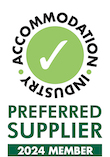Is Your Office Washroom Hurting Your Reputation? 4 Tips to Improve Hygiene
We have all read articles giving tips on how to improve washroom hygiene and the same old tips apply. Regular cleaning, disinfecting and using the correct products - these are all well-known techniques.
But what if you are doing all the right things but your washroom still does not pass the test? What could you be doing wrong?
Every minute that your employees are displeased with the washrooms decreases their morale. They will avoid going to the washroom during the workday. This may cause health problems and decrease overall productivity.
Basic cleanliness may not be enough to raise the standards of your washrooms. It may take a more user-centric approach.
Before moving on to less obvious ways to keep your washroom clean, make sure you have the basics covered.
Basic Ways to Keeping Workplace Washrooms Pristine
1. Clean in Sequence
Regular cleaning is essential for all public restrooms. The office's foot traffic will determine the frequency of cleaning.
The sequence of cleaning also needs to be standardised and implemented. Make sure your cleaners do not inadvertently re-contaminate surfaces.
Follow the below sequence when cleaning the restroom:
- Place cautionary signs at the entrance to the washroom.
- Inspect and note all damaged equipment.
- Empty all trash cans.
- Sweep floors.
- Refill all dispensers (tissue, soap and feminine hygiene products).
- Pre-treat urinals and toilets.
- Clean countertops, sinks, taps and mirrors.
- Scrub toilets and urinals.
- Mop the floors.
- Disinfect cleaning equipment.
- Report damages in the washroom.
2. Disinfect Washrooms
Depending on the products used, cleaning may not necessarily mean sanitising. Cleaning tools can simply move germs from one surface to another.
It is important to use a separate disinfectant to make sure surfaces are germ-free. Studies show that disinfectants lower the level of germs on surfaces to a level that is safe for humans.
The surfaces should be left to air dry before wiping with a disinfectant solution. This is usually a bleach-based liquid which is able to kill the disease-causing germs.
Some of these include coronavirus, E-coli, salmonella, hepatitis A and norovirus. Disinfecting reduces the chance of illness and precious time off work.
3. Restock Consumable Products
Hygiene can only be maintained if workers are given the correct products.
There needs to be a sufficient supply of consumables at all times.
Commercial tissue paper is easily available and orders can be made online.
Modern dispensers make it possible to provide two rolls of 3000-sheet tissue paper. There is no longer any excuse for this necessity to run out.
Drying hands is as important as washing them.
To make sure employees do not spread germs, provide them with paper towels.
By using paper hand towel dispensers, workers have easy access to paper towels.
Other products such as handwashing soap and hygiene products also need to be kept in stock.

|

|

|
4. Provide Sanitary Cleaning Equipment
The equipment used should be in line with the purpose of the cleaning. To reach joints and corners will require specialised tools.
Sanitisers and agents vary according to the type of surface they clean so make sure to use the correct one.
 Source: freepik
Source: freepik
Equipment such as mops, brushes, wipes and brooms need to be properly disinfected.
After cleaning, supervisors must ensure the cleaner uses the correct agents to clean the equipment. This will get rid of unsavoury smells and bacteria.
Further Steps to Improving Washroom Hygiene
After taking care of the basics, keep reading for a few more not so obvious tips on how to improve your office washroom hygiene.
1. Influence Good User Behaviour
Toilets do not get dirty on their own. There is a human element in the process of making a bathroom dirty. Natural body functions can sometimes be messy and there is not much one can do.
You can, however, influence how people use the washrooms and the state they leave them in.
There are some subtle ways to improve how people use the restroom as shown in the table below.
| Lighting |
|
|
| Building Materials |
|
|
| Smart Technology | Incorporate smart/automatic devices in equipment |
|
| ‘Looscaping’ |
Place decorative elements such as:
|
Makes for a pleasant environment which users want to keep clean. |
2. Use Public Education Signs
A study in 2017 showed that people were more likely to wash their hands after seeing a sign instructing them to. This applied to 44% in men and 34% in women.
Office washrooms can use educational materials to make sure that cleanliness is top of mind for users.

Source: pixabay.com
When designing the message, use simple visuals that are eye-catching. The language used should not be higher than that of a grade 6 student. Avoid the use of negative words such as ‘don’t’. Instead, focus on polite prompts.
Some examples are:
- Please keep the toilet clean.
- Remember to wash your hands.
- Please put all litter into the rubbish bins.
Humour is also a good way to get the message across as readers won’t forget the cheeky reminder.
“ Treat Me Well and Keep Me Clean, I’ll Not Tell Anyone What I Have Seen.” — thefreshquotes.com
Delivering the message will help it become internalised. Delivery methods include posters and stickers on the walls and doors.
They can also be audio or via feedback panels. The correct delivery and positioning will maximise the effectiveness of the message.
3. Promote Good Ventilation
A fresh smelling washroom is indicative of a clean space. Although it does not mean the bathroom is 100% clean, it makes visiting the toilet a more pleasant experience.
Promoting proper ventilation will aerate areas and get rid of malodours. Ideally, there should be natural ventilation from open windows and inlet grilles.
An easy way to allow for the free flow of air is to use a doorless entrance which leads to an entrance maze. If you must use doors, let them be easy to open and close so even workers can control the flow of air.
If possible, provide aerosol sprays for workers to use before they leave the washroom. Invest in automated sprays to regulate the amount of air freshener used.
4. Take Advantage of Smart Devices
Managers can use technology to support efforts to improve hygiene in their businesses.
There are numerous devices which are designed to reduce contact within washrooms. Ideally, they are supposed to minimise cross-contamination between surfaces.
Take a look at these and decide if they are an option for your organisation.
-
Touchless sink faucets
Research has shown that sinks are the most contaminated surface in shared washrooms. Touchless bathroom faucets reduce contact and contamination of users’ hands. They also save water by automatically switching off.
-
Touchless soap dispensers
Apart from reducing contact, these dispensers control the amount of liquid dispensed. Dispensers generally limit germ exposure more than bar soaps which harbour bacteria. This is especially important if someone who is sick uses them.
-
Touchless paper towel dispensers
It has been shown that bacteria prefer wet surfaces and will spread easily via wet hands. Providing touchless paper towel dispensers reduces this risk. It also controls the amount of paper dispensed to prevent misuse.
-
Light sensors

Source: pixabay.com
More organisations are recognising the savings offered by using lighting sensors.
The market for sensors offer a wide range of products which remove the need for switches. These can be placed inside washrooms and only switch on when human activity is detected.
-
Automatic ventilation
Good ventilation reduces the amount of moisture in washrooms and inhibits the growth of harmful organisms. By automating ventilation systems, there is a constant flow of fresh air which vacates bad odours out of the washroom.
-
Self-flushing toilets & urinals
Fewer levers and buttons means less opportunities for germs to spread in the toilet. These toilets use motion or heat sensors to determine when someone has been using the toilet and automatically flush.
Take the First Step to Improving Washroom Hygiene
All of these may seem overwhelming and you are probably wondering where to begin…
It’s always easier to tackle the smallest issues first. In this case, it would be to ensure daily cleaning with the correct products.
The easiest change you can make is to provide the correct consumables and paper products.
Australia Linen Supplies offers bulk tissue paper and you can be sure of never running out. Designed to fit in the double roll tissue dispenser, this is a simple way to improve your washrooms.
Paper towels are also available in bulk, along with a reliable paper tissue dispenser.
Take your workplace hygiene to the next level and contact ALS today.
Source: myjanitors

















